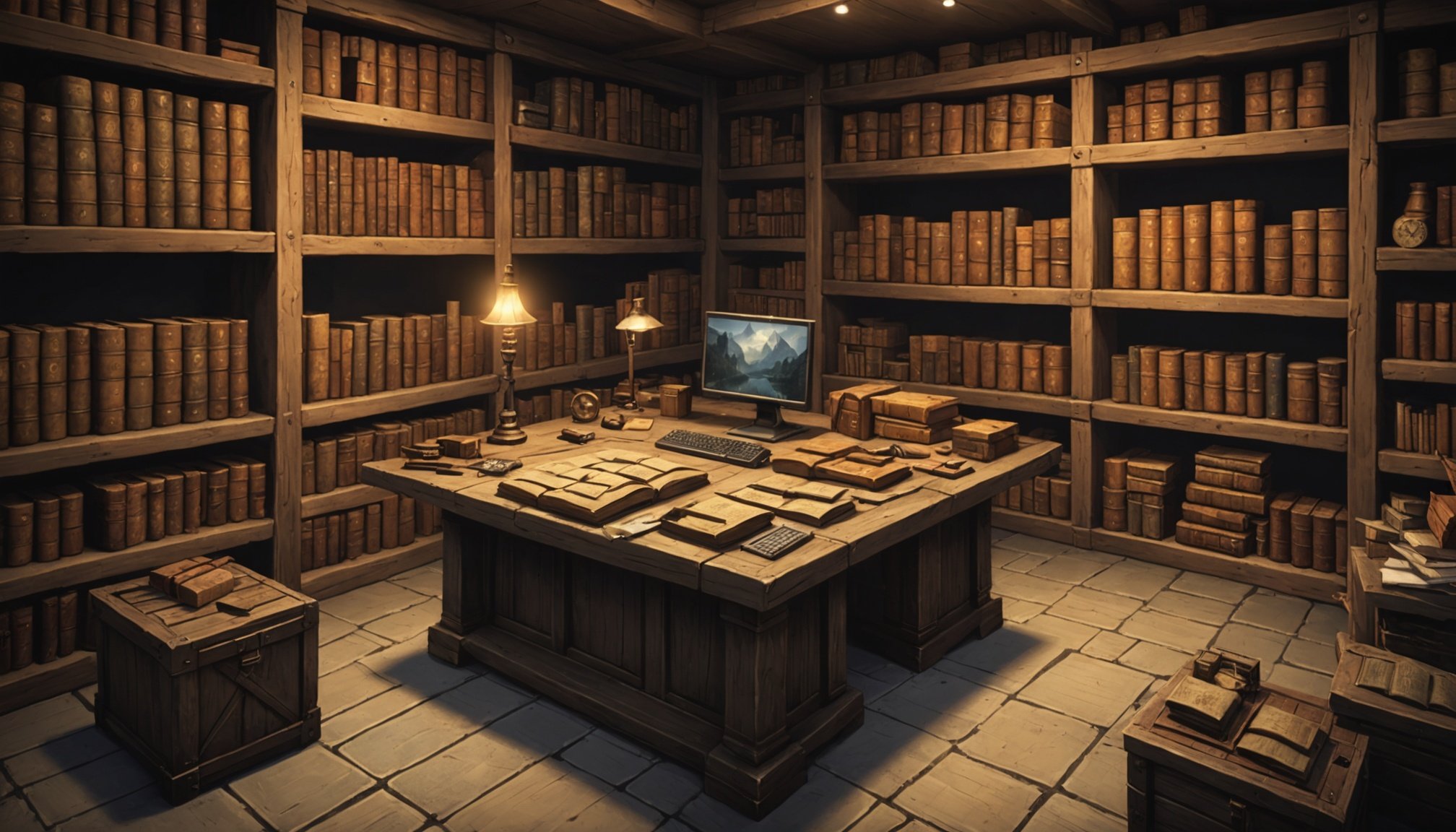Understanding the Core Elements of Inventory Systems
When diving into Inventory Design within RPG mechanics, key components emerge that can significantly enhance the User Experience. Core elements like item slots, categorization, and viewing panels must be carefully considered. These elements form the backbone of effective inventory management, facilitating smooth gameplay.
A well-designed system balances complexity and usability. On one hand, complexity can deepen engagement by offering diverse categories and strategic layering. On the other hand, usability ensures that navigating these layers doesn’t become a cumbersome task, maintaining player enjoyment.
Also to discover : Unlocking Photorealistic Character Textures: Proven Techniques for Next-Gen Gaming Mastery
The role of User Experience in inventory systems cannot be overstated. An intuitive design enhances accessibility, allowing players to manage their inventory without frustration. This involves organizing items in a manner that intuitively guides the user through their options, creating a seamless interaction between the player and the game.
Ensuring Balance
Designing these systems requires a delicate balance. Include too many options, and the player might feel overwhelmed. Offer too few, and the strategic depth could be lost. By focusing on elegant RPG mechanics and a user-centric approach, developers can create systems that are both functional and enjoyable, ensuring that players remain engaged and immersed in the game world.
Have you seen this : Mastering the Art of Seamless Gameplay: Innovative Strategies for Effortless Transitions Between VR and Traditional Gaming Experiences
User Interface Design Principles
Creating a successful inventory system in an RPG demands careful attention to UI Design. Key visual elements such as the Inventory Layout and Visual Hierarchy ensure players can easily locate and manage their items. Prioritising a clear visual hierarchy distinguishes between categories of items, enhancing the player’s ability to navigate comfortably.
Key Visual Elements
Effective visual cues are crucial for clarity. Elements like colour coding and icons help differentiate between item types and rarity, facilitating quicker decision-making by players. By tailoring these visual signals, designers can provide users with instant comprehension of their inventory organisation.
Intuitive Navigation
Intuitive navigation is achieved through logical menu structuring and streamlined paths to frequently used items. Use simple and distinct paths to guide players while avoiding over-complication. Designing an inventory system that instinctively leads the player ensures ease of use, elevating the user experience.
Responsive Design
With varying screen sizes and resolutions, ensuring a responsive design becomes paramount. A dynamic layout that adjusts seamlessly according to the player’s device fosters a more inclusive gaming experience. Incorporating scalable elements allows inventory systems to remain functional and accessible across diverse platforms.
Item Categorization Strategies
Item Classification is a vital component in the management of RPG inventories. Proper categorization involves frequent grouping of RPG Items based on type or function, which enables players to access essentials effortlessly during gameplay. This organization hinges on the use of relevant labels, ensuring that similar items such as weapons, potions, or armour are stored together, helping players strategize effectively.
Incorporating Filtering Options enhances Item Classification by simplifying the search for specific items. Players can apply filters like rarity, weight, or function to swiftly locate particular RPG Items in their inventory. This functionality minimizes time spent on inventory management, enabling smoother transitions and maintaining player immersion in the game’s narrative flow.
Successful categorization in popular RPGs such as “The Witcher” showcases intelligent grouping by equipment type and purpose. Players in such games benefit from Filtering Options that permit detailed searches, accentuating the gameplay’s strategic component. Moreover, providing an intuitive tagging system is effective in classifying and retrieving items based on user preference, demonstrating best practices.
Overall, well-implemented Item Classification enables ease of use and efficient access, contributing to an engaging and seamless User Experience in RPGs. Crafting thoughtful categorization strategies and integrating practical filtering methods make navigation through inventories straightforward and satisfying.
Usability Testing for Inventory Systems
To create an efficient RPG inventory system, conducting User Testing is vital. It identifies usability issues early, ensuring a refined player experience. Feedback Loops play a central role by allowing developers to gather data from end-users and make informed design decisions. This iterative process enhances system effectiveness by continually refining based on player insights.
Conducting Effective Usability Tests
Effective user tests start with recruiting the right participants who represent the game’s target audience. Testing should incorporate realistic gameplay scenarios to emulate genuine player interactions. Gathering comprehensive feedback during these sessions ensures that tests provide actionable insights into how users interact with inventory systems.
Analyzing User Behavior
Understanding User Behavior involves tracking how players navigate and engage with the inventory. Metrics such as time taken to locate specific items or frequency of accessing certain categories can highlight areas for improvement. Analyzing these data points helps developers understand player needs and preferences better.
Implementing Feedback Mechanisms
Integrating feedback mechanisms allows for continuous improvements. These mechanisms should encourage players to share their experiences, thus enriching the Iterative Design process. Through iteration, developers can address identified issues, enhancing the usability and functionality of the inventory system while maintaining a positive User Experience.
Inventory Management Mechanics
Exploring inventory mechanics in RPGs reveals a fundamental layer of game dynamics. These mechanics define how players manage their resources, influencing both game balancing and strategy. Understanding this aspect is crucial for developers aiming to create engaging and rewarding gameplay experiences.
Different approaches to managing inventory space impact how players interact with the game. Some games provide a limited inventory, requiring strategic decisions about what to carry, enhancing player involvement. Others allow for expansive inventories, promoting resource collection but potentially reducing challenge.
Resource management is pivotal to gameplay dynamics. It requires players to weigh the value of items, whether crafting materials or consumables, and decide their utility in-game. These decisions influence game balancing: a carefully designed system avoids overwhelming players by maintaining challenges that match player abilities.
The impact of inventory mechanics extends to player strategy. Restrictive spaces can encourage creative approaches to item usage, whereas resource abundance might lead to hoarding behaviors. Allowing players to manage their inventory strategically fosters immersion and satisfaction.
By effectively implementing and balancing these mechanics, developers can enhance the player’s strategic experience, ensuring that inventory management becomes an integral and enjoyable part of RPG gameplay.
Case Studies of Successful Inventory Systems
Exploring established RPG Case Studies provides insight into strategies that enhance Player Engagement through effective Inventory Design. In the acclaimed game “Skyrim,” the inventory system efficiently categorizes items under clear headings such as Weapons, Apparel, and Potions. This Inventory Example offers intuitive navigation, allowing players to swiftly locate and manage items, directly contributing to improved user experience.
Another compelling study is “The Legend of Zelda: Breath of the Wild.” The game employs a minimalist design, focusing on essential inventory functions and reducing clutter, thus preventing Player Frustration. An innovative approach here is the efficient use of visual cues, such as iconography, to signal item status and importance, facilitating quick user decisions.
Furthermore, examining “The Witcher 3” reveals advanced filtering capabilities that empower players to organize items by type or usage frequency. This personalized sorting system streamlines management, increasing satisfaction and maintaining immersion.
Such Case Studies illustrate the impact of thoughtful inventory design. By observing these successful approaches, developers can glean valuable insights to apply in new RPG designs, ultimately optimizing UI and enhancing player experience. Emulating these best practices can assist developers in overcoming common Design Hurdles and anticipating user preferences.
Challenges in Inventory Design
Designing effective inventory systems in RPGs often presents various Design Hurdles. Among the primary challenges is creating a system that avoids Player Frustration while ensuring seamless functionality. Complex mechanics or cluttered interfaces can overwhelm users, detracting from the gaming experience.
Common Design Challenges
RPG inventory systems frequently face issues such as overly intricate Navigation Pathways and insufficient organizational strategies. Space constraints can lead to problematic resource management, requiring players to constantly reorganize or discard items. Furthermore, excessive options might confuse players, reducing their enjoyment and engagement.
Solutions and Workarounds
Addressing these challenges involves implementing Optimization Techniques such as intuitive iconography and adaptive interfaces. Streamlining categories and ensuring Responsive Design across multiple platforms can alleviate user frustration. Additionally, clear labeling and informative Visual Hierarchies enhance players’ navigational ease, reducing cognitive load.
Anticipating Player Needs
To forestall potential issues, anticipating player preferences is crucial. Developers should focus on Iterative Design processes and frequently incorporate Feedback Loops to refine systems. Prioritizing a balance between complexity and usability empowers players, fostering an enjoyable experience. By addressing Player Needs proactively, the likelihood of encountering design hurdles decreases, leading to more efficient and satisfying inventory systems.










